Michael Cerny Green
Evolutionary Machine Learning and Games
Nov 20, 2023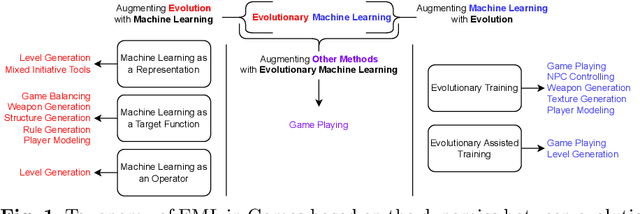
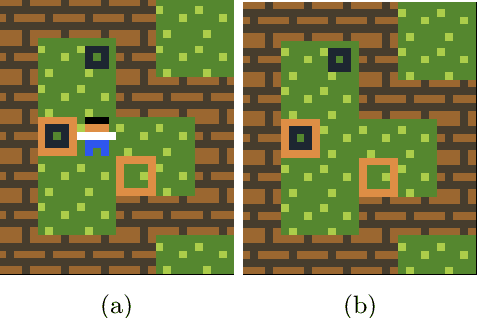


Abstract:Evolutionary machine learning (EML) has been applied to games in multiple ways, and for multiple different purposes. Importantly, AI research in games is not only about playing games; it is also about generating game content, modeling players, and many other applications. Many of these applications pose interesting problems for EML. We will structure this chapter on EML for games based on whether evolution is used to augment machine learning (ML) or ML is used to augment evolution. For completeness, we also briefly discuss the usage of ML and evolution separately in games.
Level Generation Through Large Language Models
Feb 11, 2023Abstract:Large Language Models (LLMs) are powerful tools, capable of leveraging their training on natural language to write stories, generate code, and answer questions. But can they generate functional video game levels? Game levels, with their complex functional constraints and spatial relationships in more than one dimension, are very different from the kinds of data an LLM typically sees during training. Datasets of game levels are also hard to come by, potentially taxing the abilities of these data-hungry models. We investigate the use of LLMs to generate levels for the game Sokoban, finding that LLMs are indeed capable of doing so, and that their performance scales dramatically with dataset size. We also perform preliminary experiments on controlling LLM level generators and discuss promising areas for future work.
Learning Controllable 3D Level Generators
Jul 06, 2022



Abstract:Procedural Content Generation via Reinforcement Learning (PCGRL) foregoes the need for large human-authored data-sets and allows agents to train explicitly on functional constraints, using computable, user-defined measures of quality instead of target output. We explore the application of PCGRL to 3D domains, in which content-generation tasks naturally have greater complexity and potential pertinence to real-world applications. Here, we introduce several PCGRL tasks for the 3D domain, Minecraft (Mojang Studios, 2009). These tasks will challenge RL-based generators using affordances often found in 3D environments, such as jumping, multiple dimensional movement, and gravity. We train an agent to optimize each of these tasks to explore the capabilities of previous research in PCGRL. This agent is able to generate relatively complex and diverse levels, and generalize to random initial states and control targets. Controllability tests in the presented tasks demonstrate their utility to analyze success and failure for 3D generators.
Learning to Generate Levels by Imitating Evolution
Jun 11, 2022



Abstract:Search-based procedural content generation (PCG) is a well-known method used for level generation in games. Its key advantage is that it is generic and able to satisfy functional constraints. However, due to the heavy computational costs to run these algorithms online, search-based PCG is rarely utilized for real-time generation. In this paper, we introduce a new type of iterative level generator using machine learning. We train a model to imitate the evolutionary process and use the model to generate levels. This trained model is able to modify noisy levels sequentially to create better levels without the need for a fitness function during inference. We evaluate our trained models on a 2D maze generation task. We compare several different versions of the method: training the models either at the end of evolution (normal evolution) or every 100 generations (assisted evolution) and using the model as a mutation function during evolution. Using the assisted evolution process, the final trained models are able to generate mazes with a success rate of 99% and high diversity of 86%. This work opens the door to a new way of learning level generators guided by the evolutionary process and perhaps will increase the adoption of search-based PCG in the game industry.
Persona-driven Dominant/Submissive Map (PDSM) Generation for Tutorials
Apr 11, 2022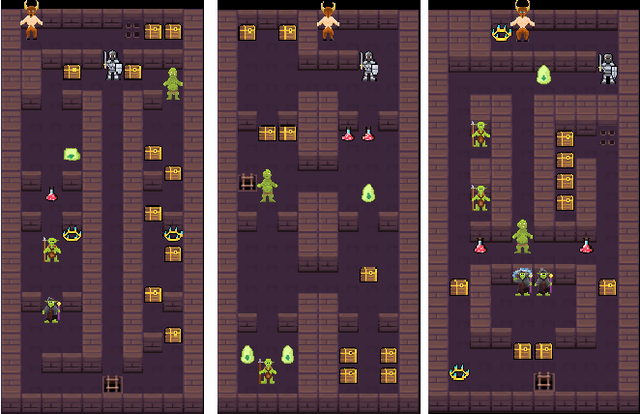



Abstract:In this paper, we present a method for automated persona-driven video game tutorial level generation. Tutorial levels are scenarios in which the player can explore and discover different rules and game mechanics. Procedural personas can guide generators to create content which encourages or discourages certain playstyle behaviors. In this system, we use procedural personas to calculate the behavioral characteristics of levels which are evolved using the quality-diversity algorithm known as Constrained MAP-Elites. An evolved map's quality is determined by its simplicity: the simpler it is, the better it is. Within this work, we show that the generated maps can strongly encourage or discourage different persona-like behaviors and range from simple solutions to complex puzzle-levels, making them perfect candidates for a tutorial generative system.
Predicting Personas Using Mechanic Frequencies and Game State Traces
Mar 24, 2022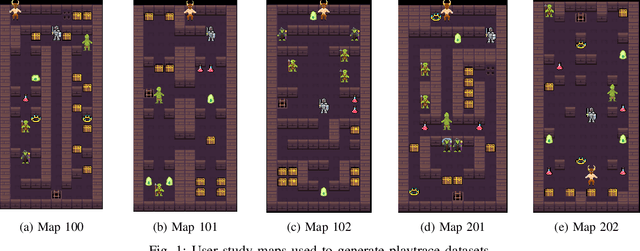
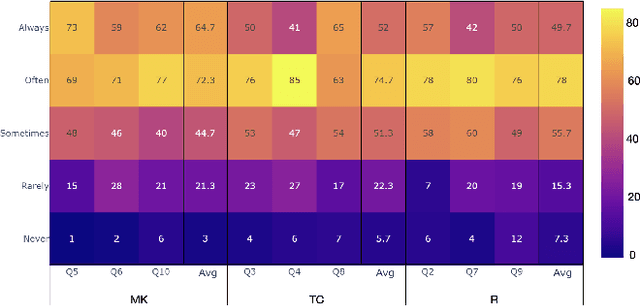


Abstract:We investigate how to efficiently predict play personas based on playtraces. Play personas can be computed by calculating the action agreement ratio between a player and a generative model of playing behavior, a so-called procedural persona. But this is computationally expensive and assumes that appropriate procedural personas are readily available. We present two methods for estimating player persona, one using regular supervised learning and aggregate measures of game mechanics initiated, and another based on sequence learning on a trace of closely cropped gameplay observations. While both of these methods achieve high accuracy when predicting play personas defined by agreement with procedural personas, they utterly fail to predict play style as defined by the players themselves using a questionnaire. This interesting result highlights the value of using computational methods in defining play personas.
Physics-informed attention-based neural network for solving non-linear partial differential equations
May 17, 2021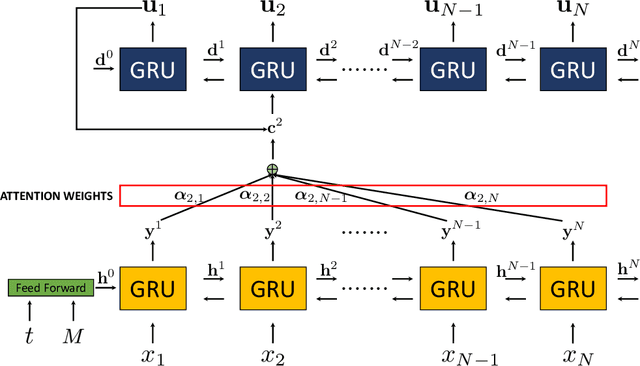

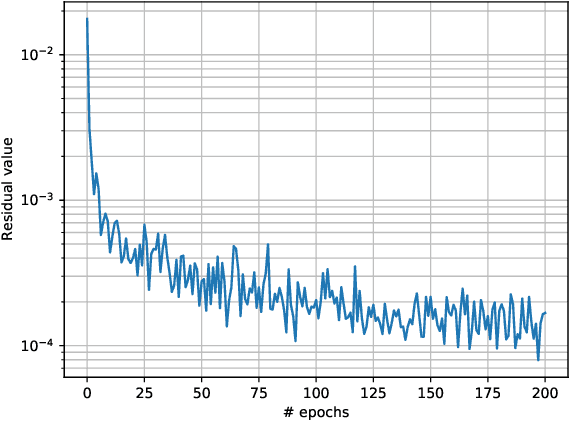
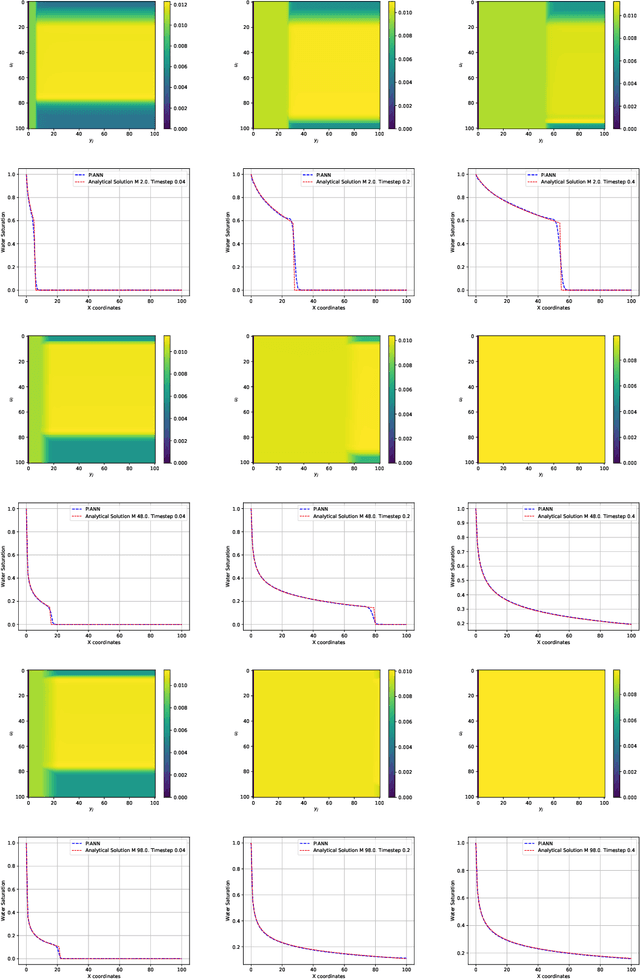
Abstract:Physics-Informed Neural Networks (PINNs) have enabled significant improvements in modelling physical processes described by partial differential equations (PDEs). PINNs are based on simple architectures, and learn the behavior of complex physical systems by optimizing the network parameters to minimize the residual of the underlying PDE. Current network architectures share some of the limitations of classical numerical discretization schemes when applied to non-linear differential equations in continuum mechanics. A paradigmatic example is the solution of hyperbolic conservation laws that develop highly localized nonlinear shock waves. Learning solutions of PDEs with dominant hyperbolic character is a challenge for current PINN approaches, which rely, like most grid-based numerical schemes, on adding artificial dissipation. Here, we address the fundamental question of which network architectures are best suited to learn the complex behavior of non-linear PDEs. We focus on network architecture rather than on residual regularization. Our new methodology, called Physics-Informed Attention-based Neural Networks, (PIANNs), is a combination of recurrent neural networks and attention mechanisms. The attention mechanism adapts the behavior of the deep neural network to the non-linear features of the solution, and break the current limitations of PINNs. We find that PIANNs effectively capture the shock front in a hyperbolic model problem, and are capable of providing high-quality solutions inside and beyond the training set.
Exploring open-ended gameplay features with Micro RollerCoaster Tycoon
May 10, 2021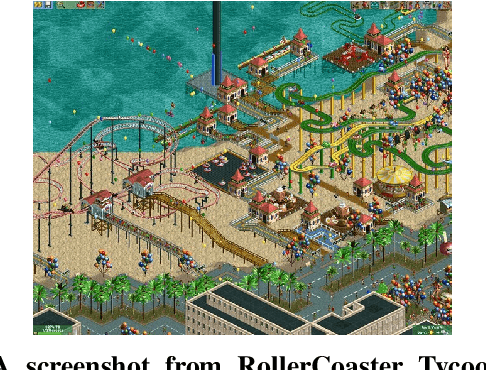
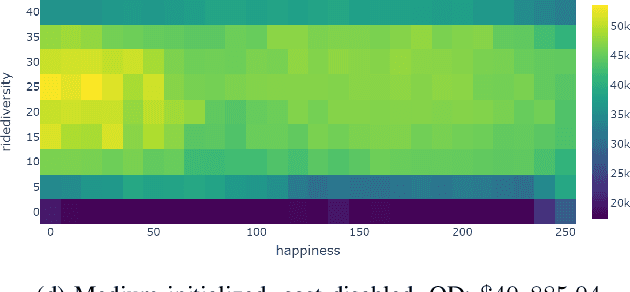
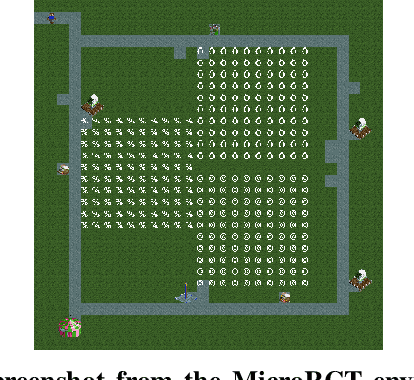
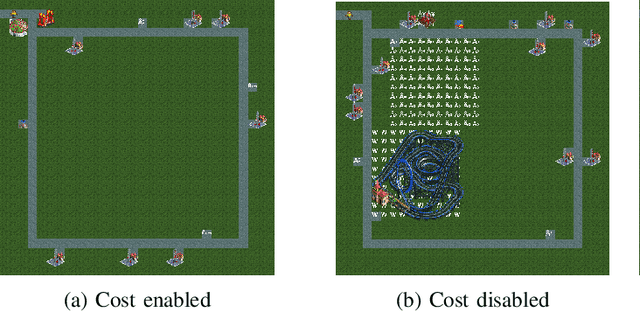
Abstract:This paper introduces MicroRCT, a novel open source simulator inspired by the theme park sandbox game RollerCoaster Tycoon. The goal in MicroRCT is to place rides and shops in an amusement park to maximize profit earned from park guests. Thus, the challenges for game AI include both selecting high-earning attractions and placing them in locations that are convenient to guests. In this paper, the MAP-Elites algorithm is used to generate a diversity of park layouts, exploring two theoretical questions about evolutionary algorithms and game design: 1) Is there a benefit to starting from a minimal starting point for evolution and complexifying incrementally? and 2) What are the effects of resource limitations on creativity and optimization? Results indicate that building from scratch with no costs results in the widest diversity of high-performing designs.
The AI Settlement Generation Challenge in Minecraft: First Year Report
Mar 27, 2021



Abstract:This article outlines what we learned from the first year of the AI Settlement Generation Competition in Minecraft, a competition about producing AI programs that can generate interesting settlements in Minecraft for an unseen map. This challenge seeks to focus research into adaptive and holistic procedural content generation. Generating Minecraft towns and villages given existing maps is a suitable task for this, as it requires the generated content to be adaptive, functional, evocative and aesthetic at the same time. Here, we present the results from the first iteration of the competition. We discuss the evaluation methodology, present the different technical approaches by the competitors, and outline the open problems.
* 14 pages, 9 figures, published in KI-K\"unstliche Intelligenz
Game Mechanic Alignment Theory and Discovery
Feb 20, 2021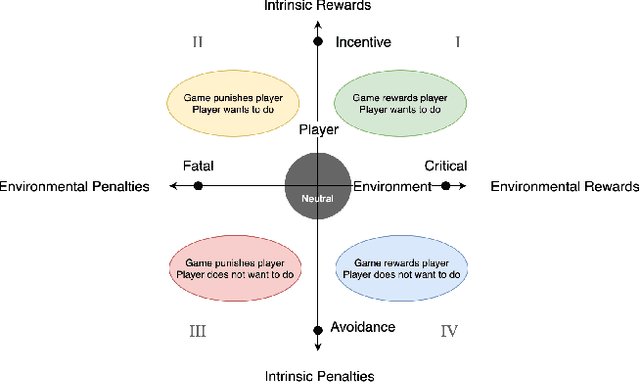
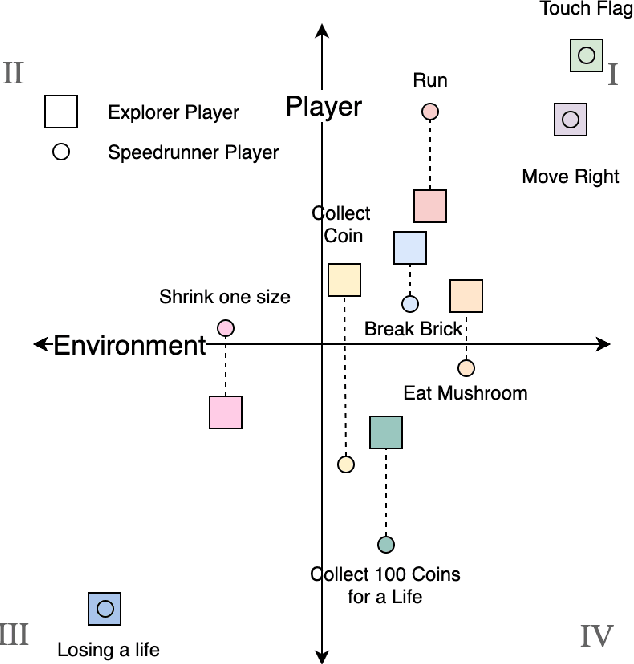
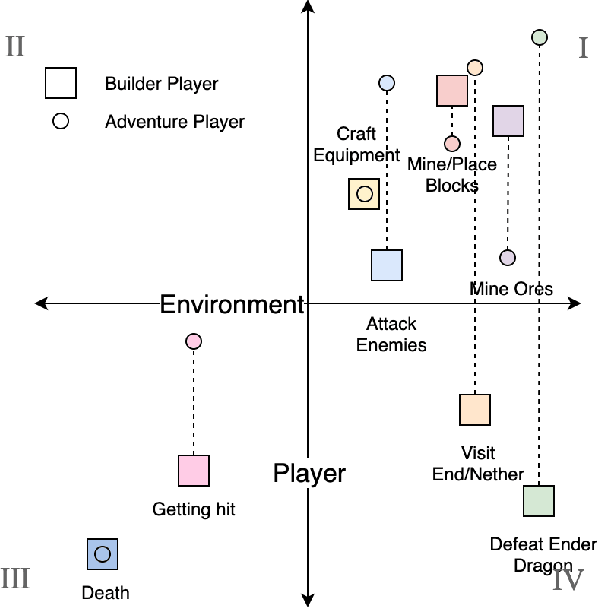
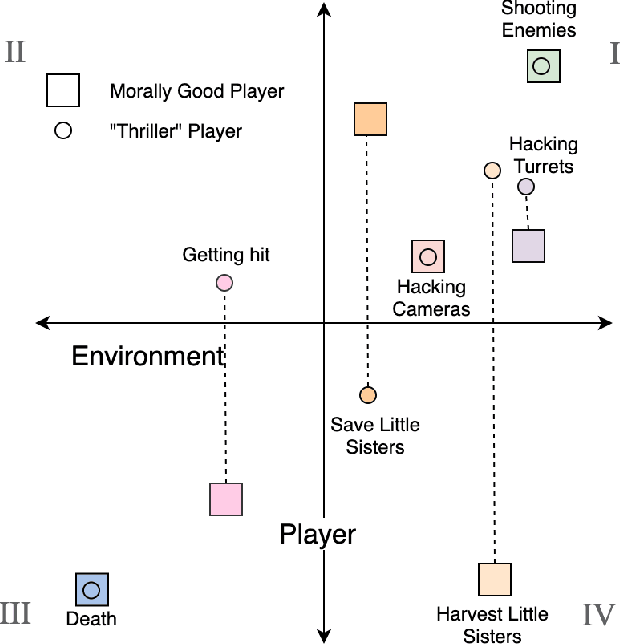
Abstract:We present a new concept called Game Mechanic Alignment theory as a way to organize game mechanics through the lens of environmental rewards and intrinsic player motivations. By disentangling player and environmental influences, mechanics may be better identified for use in an automated tutorial generation system, which could tailor tutorials for a particular playstyle or player. Within, we apply this theory to several well-known games to demonstrate how designers can benefit from it, we describe a methodology for how to estimate mechanic alignment, and we apply this methodology on multiple games in the GVGAI framework. We discuss how effectively this estimation captures intrinsic/extrinsic rewards and how our theory could be used as an alternative to critical mechanic discovery methods for tutorial generation.
 Add to Chrome
Add to Chrome Add to Firefox
Add to Firefox Add to Edge
Add to Edge